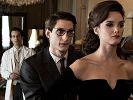Eye For Film >> Movies >> Yves Saint Laurent (2014) Film Review
Yves Saint Laurent
Reviewed by: Anne-Katrin Titze

Jalil Lespert's Yves Saint Laurent is a necklace of emotionally exact, exquisitely acted moments. Pierre Niney plays Saint Laurent as a pale sheaf of nerves, jittery and brilliantly alive, a masterful study of awkwardness that not even once becomes cartoonish. The way he holds his fork at the various dinners tells us everything about his state of mind and stomach at the time and how many fingers he uses to push up his ever slipping eyeglasses indicates fluster or calm. The way these moments are linked can seem a little haphazard, yet the film does not fall into the plot traps of so many biopics, especially those on artists.
Lespert's take on Saint Laurent has two beginnings. One in 1957 in Orage, Algeria, the designer genius' birthplace, where we see him from behind at his desk in front of the window, drawing, while his stylish mother downstairs tells her lady friends about her son's work as assistant to Christian Dior.

The second beginning of the film is with Pierre Bergé, played with equal depth by Guillaume Gallienne who is, as Niney, an actor of the Comédie Française. Bergé we first see in the recent past and hear his voice-over recollections after Saint Laurent's death in 2008, organising the auction of their belongings. It is the time chronicled in Pierre Thoretton's insightful documentary L'Amour Fou from 2010, which makes a good companion piece to Lespert's fictional portrait forward from 1957 and backward from 2009 to tell the love story between the two men. The actors have great chemistry and potently communicate things about human behavior in relationships, universal and specific, self-destructive and kind.
A great deal of skill went into the circumvention of the obvious and it paid off. "Show me how you would take in the waist," demands Dior (Patrice Thibaud) and we see Saint Laurent drape a version of his first dress for the couture house, the one made famous by Richard Avedon in 1955 for Harper's Bazaar, the one with the model between two elephants. We get the draping of the fabric and her posture, you have to add Avedon and the elephants from your own files of cultural memory. This is how we meet the model Victoire (Charlotte Le Bon), a pawn for jealousy and revenge between the two men. She is the fetching catalyst who brings out the worst in them until she is replaced by more modern muses. "Her style is yesterday's news" marks the kiss of death in the fashion world.
For an authorised film, including the truly breathtaking original dresses from the Saint Laurent Foundation, the characters plunge deep into the glittering abyss of abuse and self destruction. Lespert, who had the support of Bergé, Saint Laurent's life and business partner for half a century, does not simplify inspiration by inventing bogus chance encounters. The cool legend spun here is much more subtle.
Saint Laurent, who became head of the couture House of Dior at age 21 and soon opened his own emporium, is shown here as a disaster during press conferences. He has to be rescued by Bergé with offers of champagne for the ladies of the press and harsh whispers to the blabbering designer to whom he had promised his never ending protection. With the decades of their partnership, the colours change, and their spectacular apartment with its grassy terrace looking out over the Arc de Triomphe assembles a new cast of elegant visitors. The pale, sun-bleached lime tones of the Fifties when the couple first meets turns to the deep blues and silver luster of the Seventies.
Karl (Nikolai Kinski), unmistakably Lagerfeld, though never explicitly mentioned by last name, is a hovering presence - first as assistant and then part of the endless traveling party, Andy Warhol et al. We see Saint Laurent meet his muse Betty Catroux (Marie de Villepin) in a club and in the pool of the couple's villa in Marrakesh, the glorious Loulou de la Falaise (Laura Smet) who assisted him with extraordinary jewelry, stages the Proust questionnaire like a duel. What quality do you appreciate most in a man? "Body hair," is his smiling answer. And in a woman, "body hair," he says with a grin.
"Military was not your thing," Bergé's voice-over moves on in the early Sixties to Saint Laurent's diagnosis as manic-depressive and the ultimate question, if he wants to live or to die. Opening their own fashion house is the answer and although the fragile artist loses hair in clumps, his design star is rising, lizard over-knee boots leading the way. In Frédéric Tcheng's superb new documentary Dior And I, Raf Simons, who recently took over the House of Dior as creative director, is seen nearly fainting in anticipation of having to take his bow after his debut collection. Saint Laurent seems to have felt the same.
Then there are the clothes, and this is where Yves Saint Laurent shines brightest. In the tradition of Charles Vidor's Cover Girl (1944) or the Fred Astaire and Ginger Rogers RKO musical Roberta (1935), the fashion shows are placed to thrill you in their fantasy, a nostalgia for the new that works independently of time.
Saint Laurent's 1962 navy blazer, and later the smashingly successful "Liberation" collection which invented Le Smoking are a treasure to behold. Lespert decides to culminate the Saint Laurent experience with Maria Callas, La Traviata, and the 1976 Russian Ballet Collection.
Saint Laurent is shown here as a less than nice person and he knows it. Alcohol, drugs, sex with people to harm the loved ones frame the backdrop to creations of extraordinary beauty always right at the pulse of the times. Bold and beautiful, this is a film where clothes can make you cry.
Reviewed on: 13 Jun 2014


















